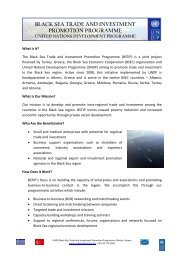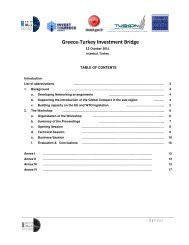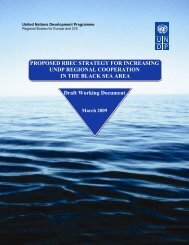Tradeflow Study - UNDP Black Sea Trade and Investment Promotion ...
Tradeflow Study - UNDP Black Sea Trade and Investment Promotion ...
Tradeflow Study - UNDP Black Sea Trade and Investment Promotion ...
Create successful ePaper yourself
Turn your PDF publications into a flip-book with our unique Google optimized e-Paper software.
Annex 2.2. Methodological aspects of <strong>Trade</strong> Flow Analysis<br />
The trade flow analysis computes the sub-regional exports to the world <strong>and</strong> imports from the<br />
world for each country in the region at the most detailed level of classification available 9 . The<br />
data used comes from the UNSD Comtrade Database using 2005 data. Missing country data<br />
has been constructed using bilateral (mirror) statistics. Thus for over 5,000 product groups,<br />
the indicative export potential has been calculated when one country is an exporter of a<br />
product group to the world, while the rest of BSEC member countries are importers of that<br />
same product group. The indicative import potential of a country is calculated when one<br />
country is an importer of a product group from the world <strong>and</strong> the rest of BSEC is an exporter<br />
of that same product group to the world. The indicative potential is calculated as the lower<br />
value between the two. Formally, the indicator is calculated as:<br />
I<br />
min( X , M ) X<br />
ik<br />
jk<br />
ijk<br />
where X ik <strong>and</strong> M jk represent exports of country i <strong>and</strong> imports of<br />
country j respectively in product k.<br />
The trade flow analysis is used to provide an indication of the potential for trade between a<br />
country <strong>and</strong> the rest of the region. Since the level of disaggregation is relatively high, the<br />
complementarity for trading between partner countries is considered to be relatively high.<br />
Obviously, even at this detailed level, products may not be perfect substitutes, but are<br />
considered to be closely approximate substitutes 10 . The indicative trade potential has been<br />
computed for the 5,000 product group <strong>and</strong> ranked from the highest to the lowest.<br />
9 The six digit level of the harmonised system of trade classification has been used<br />
(referred to as HS6). This is the most detailed level possible for cross country comparison<br />
10 Helmers <strong>and</strong> Pasteels (2006) provide a study on the uses <strong>and</strong> limitations of assessing<br />
bilateral trade potential at the Commodity level.<br />
97/135






